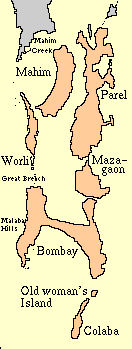Mahim History
Map of Ancient Mahim

Name-Changing Anyone? The different epithets that Mahim has had:
Bimbsthan - Prabhavati - Mahikawati - Maijim - Mahim
The former island of Mahim has a romantic and chequered history. It is one of the seven islands that originally made up Mumbai.
Mumbai, the commercial capital of India, and often called the city of dreams, is located on the west coast of India, in the state of Maharashtra. Mumbai is to India, what New York is to the USA, or what London is to Great Britain.
The seven islands which together were called Bom Baia by the Portuguese meaning Good Bay were:
Colaba, Mazagaon, Old Woman's Island, Worli, Mahim, Parel, and Matunga-Sion.
This group of islands, which have since been joined together by a series of reclamations, formed part of the kingdom of Ashoka, the Mighty Emperor of India who reigned from 273 B.C to 232 B.C. After him the island was ruled by several Hindu rulers till the 14th century (A.D).
Mahim, or Mahikawati as it was known, was the capital of Raja Bhimdev, who reigned over the region in the 13th century. Raja Bhimdev's origins are not clearly known. He may have come from Anahilwada-Patan in Gujarat or from the dynasty of Yadavs in Deogiri. He built a palace and a court of justice in Prabhadevi, as well as the first Babulnath temple.
During his reign he brought various communities to these islands, such as the Pathare Prabhus (the first settlers), Palshis, Pachkalshis, Bhandaris, Vadvals, Brahmins, etc. The Bhandaris were originally toddy tappers; the Vadvals were gardeners. He also introduced many fruit-bearing trees, including coconut palms to the island. Today, we cannot think of Mumbai's landscape without its swaying coconut palms.
In 1343, this island was possessed by the Mohammedans of Gujarat. It was in their reign that the old Mahim mosque was built. Dargah of Makhtum Fakir Ali Paru was built here in 1431.
In 1543, the Portuguese then took possession of the island of Bombay by force of arms. By then they were already in possession of other trading centres on the west coast such as Panjim (in Goa) and Daman & Diu. They built several churches; the St. Andrew's Church in the suburb of Bandra has the distinctive Portuguese-style facade which is very much visible even today.
A hundred and twenty-eight years after the Portuguese captured the island, it passed into the hands of, who else, but the British. This tale too is not without its romance.
In 1662, these islands were given to the English King, Charles the II, as a part of the wedding dowry for the Portuguese princess, Catherine of Braganza.
In 1668, Bombay was acquired by the English East India Company, on lease from the crown, for the annual sum of 10 pounds in gold (!). The British built the Mahim Fort here in order to protect themselves from the Portuguese.
This heritage structure has perhaps not been given its due, for today it stands virtually in ruins - a sad testimony to our times.
Anyway, continuing with our historical journey, in the 1670s, a convent of Our Lady of Salvation was built, and a Franciscan church constructed in what is now Dadar.
The East India Company shifted its headquarters from Surat to "Bombay" (corrupted by the British from "Bom Baia") in 1687. Thus Mumbai (from "Mumbadevi"- the goddess of the fisher-folk), acquired even more importance as a trading centre - it became the gateway to India, which of course was called the jewel in the crown of the British Empire. The Causeway connecting Mahim and Bandra (corrupted from "Bunder" meaning port) was completed in 1845 at a total cost of Rs.1,57,000 donated entirely by Lady Avabai Jamsetjee Jeejeebhoy, wife of the first baronet Sir Jamsetjee Jeejeebhoy with a stipulation that no toll would be charged to citizens for its use by the government.
In 1847, a small group of Scottish missionaries decided to start a new school. Charitable, god-fearing and humble, they stayed in the background working unobtrusively and leaving no trace of their names. Nevertheless, they paved the way for a glorious future for Bombay Scottish School. On 28th February 1878, the construction of the Bombay Scottish Orphanage was completed at a cost of Rs 84,015 and opened by his Excellency, the Hon. Sir Richard Temple Bart, G.C.S.I, the then Governor and President in Council.
In 1913, the Bombay Municipal Corporation opened up Mahim for development as a suburb. This was done by building three major north-south access roads, now called the Western Express highway, N. M. Joshi Marg, and Tulsi Pipe Road. And so to now, circa 2000 A.D. For such a small area, Mahim houses several places of worship. It boasts of temples, churches, mosques, and a Gurudwara - in short, something for every person of every religion. It is also in close proximity to the remarkable Maharashtra Nature Park. This park has been created out of a garbage dump, and houses a bird sanctuary. It houses 12,500 varieties of plants and several rare birds including flamingos.
With several restaurants, professionals, stores and places of recreation, Mahim can truly be likened to a buzzing beehive.
And today, Mahim is well connected with rest of Mumbai by Western railway and Harbour railway and Mahim Bus Depot, which has buses travelling to the far south Mumbai, Colaba and also to far north Mumbai, Dahisar.
